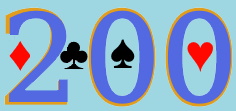
200 is a trick-taking card game from Canada, particularly popular in the
Province of New Brunswick. However, the game is also regularly played in
several other surrounding areas, sometimes under different names such as
Dix, Bidder 10, Le Rough, Deux Cents, and La Fouine. The game is also
occasionally written out as Two Hundred.
200 uses a somewhat unusual 40 card deck. This deck can be created from a standard 52 card deck by removing all cards of ranks 2, 3, 4, and 6 from that deck. The ranking of the cards as used in this modified deck are as follows (from high to low): Ace, King, Queen, Jack, 10, 9, 8, 7, 5.
200 is designed for play by four players, playing in two partnerships consisting of two players each. If not previously arranged, partnerships can be determined in a number of methods, with a common method to have every player draw a card from a shuffled deck. The players drawing the two highest cards form one partnership and the opposing partnership consists of the remaining two players. The player drawing the highest card of all also becomes the first dealer and has first choice of seats at the table. His partner should sit directly across the table from him. The remaining two players should then take seats at the table such that they are also directly across the table from each other. After each deal, the role of dealer rotates around the table in a clockwise direction.
Once the partnerships and first dealer have been determined, the designated dealer should thoroughly shuffle the cards and offer them to the player at his right to cut. After the cut, the dealer then begins dealing the cards one-at-a-time and face-down, starting with the player at his immediate left. He continues dealing in a clockwise direction until each player has a total of nine cards.
After the deal, a round of bidding takes place. The player to the left of the dealer has the first opportunity to make a bid and the bidding continues in a clockwise rotation around the table from player to player. The minimum legal bid is 50, and bids must be made in increments of 5. A bid is the number of points that player is estimating his team can capture during play of the hand. In order to be legal, a bid must be higher than any previous bid
during that round. Once a player elects to "Pass" during the round of
bidding, he may no longer may any additional bids during that same hand
and must simply state "Pass" each time the bid rotates to him on that
hand. The bidding continues until a legal bid is followed by three
consecutive passes. If all four players Pass before any player makes a bid, the cards are shuffled back together and the next dealer in turn will deal (with no score performed for that hand).
After a high bid is followed by three Passes, the high bidding player's team become the contractors for the hand and will thence attempt to capture at least as many points as bid for during the hand. After the winning bid is determined, the player making this bid then announces his choice of trump suit for the hand. He may not consult his partner in making this decision as the decision must be based on his current knowledge of the cards and previous bids by the other players (including his partner). If he forgets or chooses not to name a trump suit for the hand, the suit of the first card he plays to the first trick sets the trump suit for the hand.
The high bidder thus leads the first card to the first trick and each additional player in a clockwise direction plays one card to the same trick. In leading to a trick, a player may elect to play any card still remaining in his hand. Each other player must then play a card of the same suit as originally led to the trick if he has one. If he has no such card, he may play any card from his hand, including a card of the designated trump suit.
After each player has played one card to the trick, the trick is then won by the player of the highest card of the trump suit played to the trick. If the trick contains no cards of the trump suit designated for that hand, the trick is won by the highest card of the suit originally led to that trick. Cards won in tricks are set aside, face-down, later to be examined for scoring purposes at the end of the hand. The winner of each trick leads the first card to the next trick.
After all nine tricks have been played and won, each team examines all the cards that team was able to capture in tricks during that hand. Certain cards in the deck have a point scoring value, as per the following chart:
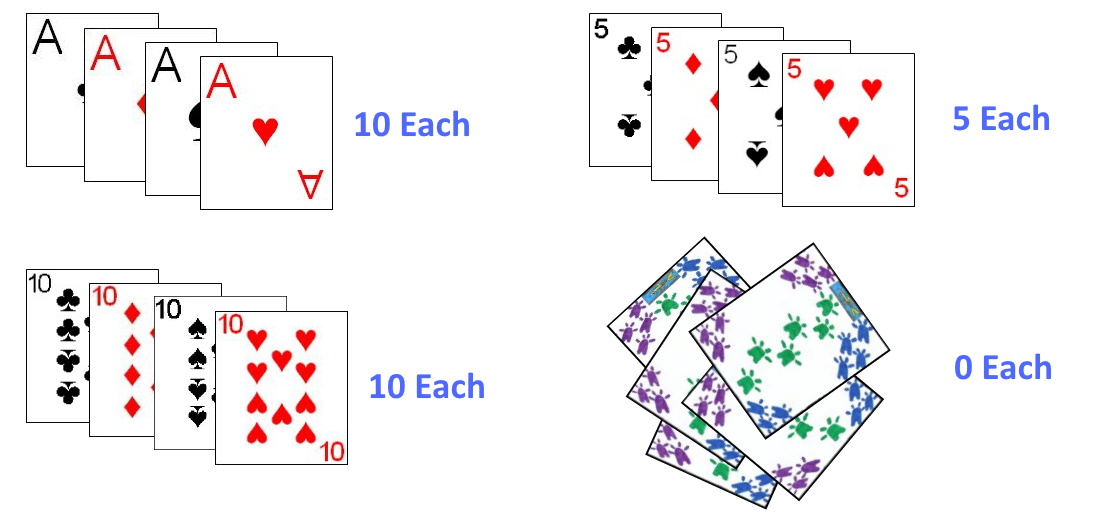
|
|
| Card | Point Value |
|---|
| Ace | 10 Each |
| 10 | 10 Each |
| 5 | 5 Each |
| King, Queen, Jack, 9, 8, 7 | 0 |
|
Scoring: If the high bidder's team manages to capture at least as many card points as bid for during the hand, they are said to have won the hand. They thus earn a score for that hand equal to the total number of points captured during the hand.
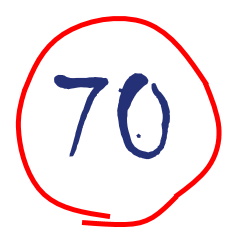
If, on the other hand, the high bidder's team does not manage to capture at least as many card points on the hand as the high bid, that team scores a minus or negative number of points equal to the bid. Negative scores are possible and common, and are represented on the score sheet by placing a circle or square around the negative score. Having a negative overall score in the game is called being "in the hole" or "in the box".
The opposing team (called the defending team) will also earn a number of points during most hands. If this defending team had a total accumulated score (before this hand) of less than 100 points they earn a score equal to the number of points that team was able to capture. If the total accumulated for that team is 100 or over, that team is still entitled to earn a score for the hand equal to the total number of points captured, but only if that team made at least one bid during the bidding round of this hand.
All scores (for both teams) earned during a hand (both positive and negative in some cases) is added to an accumulated score kept for that team.
The game can come to a conclusion in two ways. If one team, at the end of a hand, manages to earn 200 or more points that team is declared the winner of the game. If both teams, at the end of a hand, reach or exceed 200 points, the bidding team is set as the winner of the game. The game also ends if one team reaches or drops below -200 points at the end of a hand. In this case, the opposing team is immediately declared the winner of the game.
Two Player Two Hundred: A variant of 200 for two players has also been created. The same deck as used in the standard four player variant is used with the same card ranking and using the same card point totals.

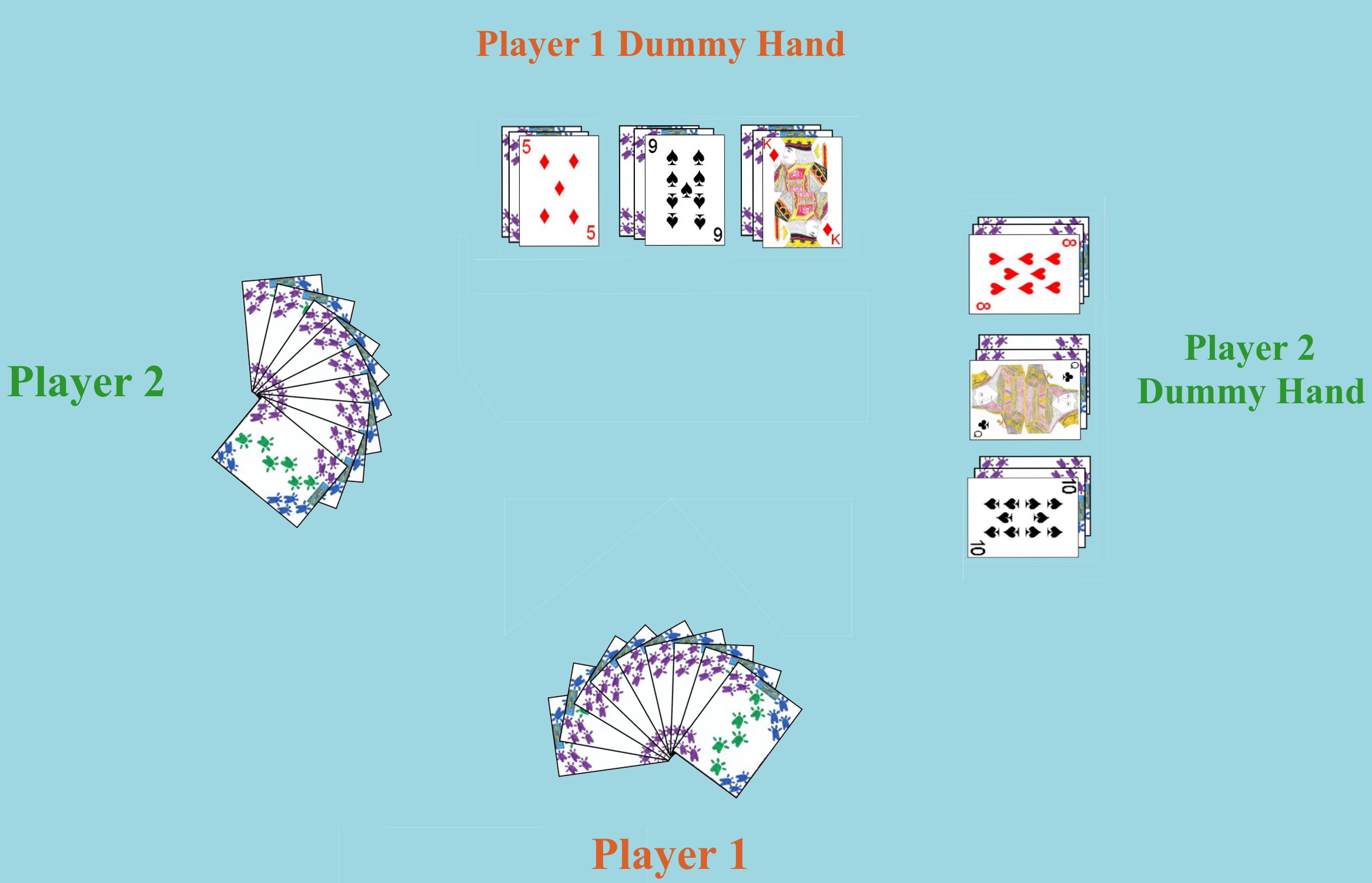
Although only two players are actively participating in the game, four individual hands are actually dealt. Each player is dealt a nine card hand as normal. However, directly across from each player is dealt a dummy hand. This dummy hand is that player's silent partner
(vice an actual player sitting at that position). The dummy hand still consists of nine total cards, however it is dealt in three piles of three cards each. The top card of each of these three piles in each of these hands is turned face up on the table. These dummy hands should be dealt directly across from each player such that gameplay will occur as if there were four active players in the hand.
The bidding occurs as in the normal game, but only the two actual players will participate. Once a high bid is followed by a Pass by his opponent, the player making the high bid is considered the contractor or high bidder for the hand. That player, with the aid of his silent partner will then attempt to earn at least as many card points as bid for.
As in the standard game, the high bidder leads the first card to the first trick, and each trick consists of four cards, one card from each player and one card from each dummy hand. Each hand should play in it's normal clockwise order. Each player is entitled to play from the dummy hand directly across from him (his silent partner). He may play any of the three face-up cards from that hand. The hand must follow suit, if able from these three available cards. After playing a card from one of the three piles in a dummy hand, the next face-down card in that pile should then be turned-up such that it will be available for possible play in the next trick. If a dummy hand wins a trick, that hand will lead to the next trick. All tricks won by a player and his dummy hand will thus be counted at the end of the game for determining the scoring for the hand.
Scoring at the end of each hand and all other aspects of this game are played identically to the standard four-handed version as described above.
Five Player Two Hundred: Two Hundred can also be played with five players. Due to the increased number of players participating in the game, a slightly larger deck is used.
Thus, in this five-player variant, a 40 card deck is used, consisting of a standard deck with all cards lower than five removed. The ranking of the cards in this deck are as follows (from highest to lowest): Ace, King, Queen, Jack, 10, 9, 8, 7, 6, 5.
In this version there are no permanent partnerships, although the high bidder will have the opportunity to have a temporary, unknown partner. Each player thus retains his own ongoing, accumulated score during the game.
In this variant, each player receives eight total cards. The round of bidding
is performed as normal, and the bidding ends once a high bid is followed
by four consecutive passes. After the high bidder announces the trump
suit to be used for the hand, he then calls for a card he does not
currently have in his hand. Whichever other player has this card in hand
becomes that player's partner. However, that player does not announce this nor make any other indication that he is the partner of the bidder. This will, of course become obvious later in the hand, particularly once the called card is played to a trick.
At the end of the hand, as normal the scoring takes place. If the bidder and his previously hidden partner managed to capture at least as many card points as bid by the high bidder, each of these players score the amount of card points captured by those two players combined during the hand. Each other player scores the number of points he managed to capture during the hand.
In all other aspects the rules of the five player version of this game are identical to those in the standard four player version.
200 With a Kitty: If the standard rules are not followed, 200 With a Kitty (Two-Hundred with a Kitty) is one of the most popular variants of 200 currently adhered to. It slightly increases the normal deck as used for the game 200 by using a 40 card deck. This deck is formed by removing all cards of four and under from a standard deck. The ranking of the cards in this deck, are as follows (from highest to lowest): Ace, King, Queen, Jack, 10, 9, 8, 7, 6, 5. Similar to the parent game, 200 With a Kitty is also played by four players playing in two partnerships.
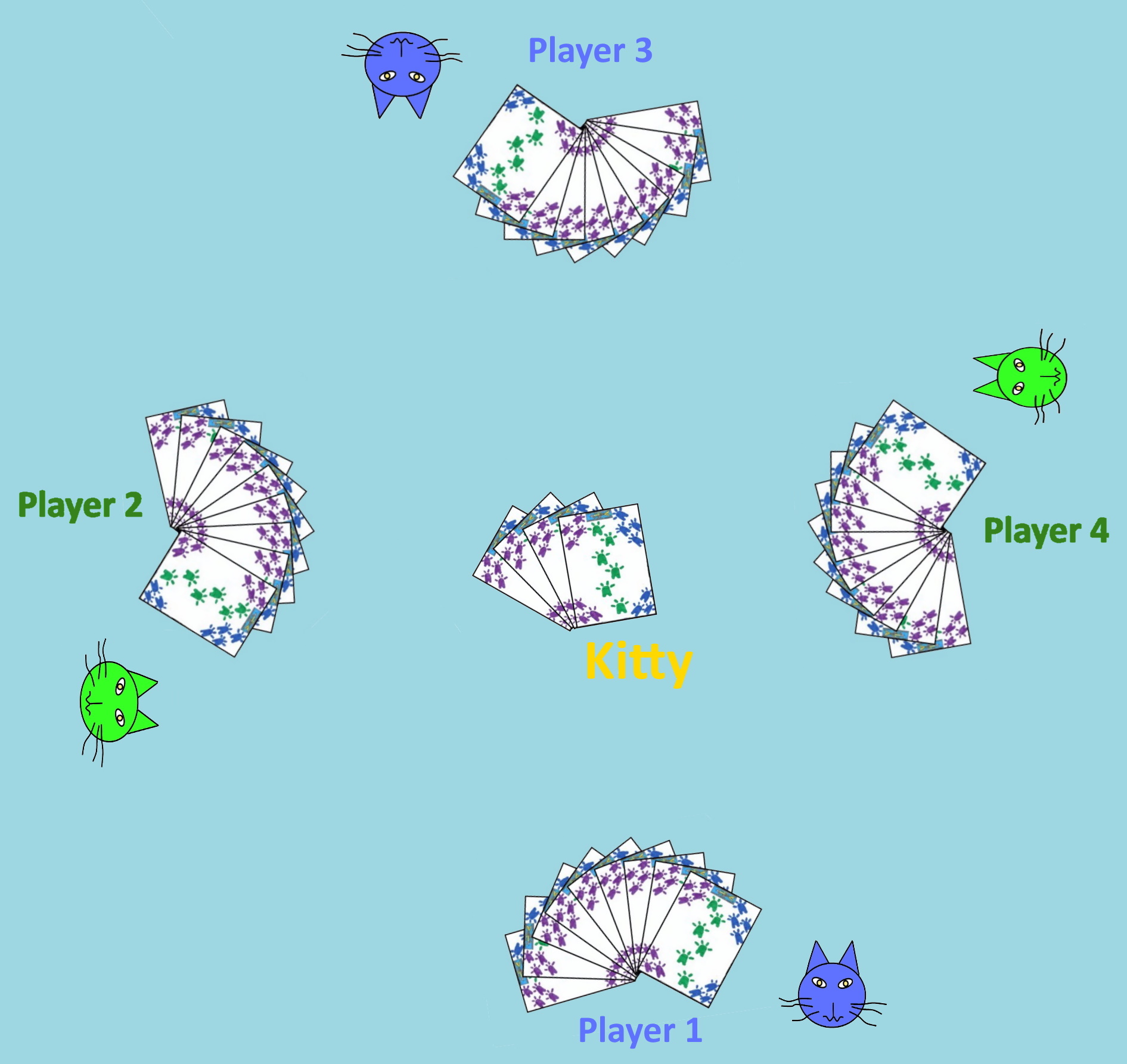
This variant is played identically to the standard game of 200 save the following differences:
- The method of dealing is modified from the standard variant. In this version, the dealer first deals each player receives a three card packet. After this the dealer deals two cards to the middle of the table for formation of a
kitty. The dealer then deals another packet consisting of three cards to each player, and then two more face-down to complete the
kitty. After this, the dealer then deals a final three card packet to each player. Each player should thus have nine face-down cards and a four card face-down kitty is in the middle of the table.
- The bidding is as normal, however the winning high bidder is entitled to take the four cards from the kitty into his hand upon completion of the bidding. The player then selects any four cards from his hand to discard to form a new face-down kitty in the middle of the table. After doing this, he then declares his choice of trump suit for the hand. At the end of the hand any card points found amongst the discarded four card kitty, are awarded to the defending team.
In all other aspects this variant of 200 is played identically to the standard version as described above.
Le Rough: Le Rough is a variation of 200 which is particularly popular in the Province of Quebec. This variant uses the same 36 card deck as is used in the standard version of 200 and is also designed for four players, playing in two partnerships. The game is played identically to the standard version of 200, with the following differences:
- During the deal, each player receives a total of eight cards. Thus, first each normally receives a face-down packet of three cards, then two cards are dealt face-down to form a kitty in the middle of the table. Then, each player receives three additional cards, and two more cards are dealt face-down to the kitty. Lastly, each player receives a packet of two additional cards. Each player should thus have a total of eight cards, and a four card kitty is found in the middle of the table.
- The bidding in Le Rough is the same as in the standard game, however the highest bidder is entitled to take the four card kitty into his hand, and then select any four cards from the hand and discard them face-down to the middle of the table as a new kitty. Any point-scoring cards found in the new kitty at the completion of the hand are awarded to the defending team.
- After discarding, the high bidder may then name his choice of trump suit or may select a contract of "No trump".
- In contracts of a trump suit, the play of the game occurs as normal. If the declared contract is "No trump", each trick is won by the highest card of the suit originally led to the trick.
- The lowest minimum bid during the bidding round is 70.
- Card point values and the scoring are identical to the standard game, however if the contract was in "No trump", the final point values awarded to the teams for that hand is doubled.
- The high bidder, may, at his option, declare that his team will win all 100 card points during the hand. He must do this before taking the kitty and discarding. If his team is successful in this bid, his team automatically wins the entire game. However, if his team fails to do this, the opposing team (the defenders) wins the game instead.
- The required score to win the game is 350 points.
- If the first three bidders pass, the dealer must also pass on his turn, and the cards are thrown in for a new hand by the next dealer in turn.
In all other aspects Le Rough is played identically to the standard game of 200.
Cutthroat Two Hundred: 200 is sometimes played without partners. The game is still played by four players, however in the cutthroat version, each player plays and scores individually, for himself.
Thus, each player will retain his own individual score. Thus, if the winning contractor manages to earn as many points as his high bid, he is entitled to score the total number of card points captured during the hand, and each opponent is also entitled to score for the total number of points they were able to capture. If the high bidder does not manage to earn at least as many points as bid, he scores a negative number of points equal to his high bid, and each opponent is still entitled to score for the number of card points captured during the hand. As each player is playing independently, the minimum bid is usually lowered to 25.
 Six Player Two Hundred
Six Player Two Hundred: A variant of 200 for six players is also sometimes played. This game uses the same 36 card deck as is used in most other versions of 200. Due to the increased number of players, each player will receive exactly six cards during the deal.
There are two methods of dividing the teams for the six player variant. The players can either be divided into two teams of three players each or they can be divided into three teams of two players each. If two teams are used, the players should sit at the table in such a manner, that each player has an opponent to his left and to his right. For the three team version, the players should be seated such that each player will be seated directly opposite his partner at the table.
In the three team version of the game, if any team, at the conclusion of a hand finds themselves to have a score of -200 or more, that team must drop from the game. The remaining two teams then
continue play using the standard 200 rules (as for four players).
Other then these few differences, this version of the game is played identically to the standard version as described above.
Copyright © 2015
CatsAtCards.com. All rights reserved.
 200 is a trick-taking card game from Canada, particularly popular in the
Province of New Brunswick. However, the game is also regularly played in
several other surrounding areas, sometimes under different names such as
Dix, Bidder 10, Le Rough, Deux Cents, and La Fouine. The game is also
occasionally written out as Two Hundred.
200 is a trick-taking card game from Canada, particularly popular in the
Province of New Brunswick. However, the game is also regularly played in
several other surrounding areas, sometimes under different names such as
Dix, Bidder 10, Le Rough, Deux Cents, and La Fouine. The game is also
occasionally written out as Two Hundred.

 If, on the other hand, the high bidder's team does not manage to capture at least as many card points on the hand as the high bid, that team scores a minus or negative number of points equal to the bid. Negative scores are possible and common, and are represented on the score sheet by placing a circle or square around the negative score. Having a negative overall score in the game is called being "in the hole" or "in the box".
If, on the other hand, the high bidder's team does not manage to capture at least as many card points on the hand as the high bid, that team scores a minus or negative number of points equal to the bid. Negative scores are possible and common, and are represented on the score sheet by placing a circle or square around the negative score. Having a negative overall score in the game is called being "in the hole" or "in the box".

 Although only two players are actively participating in the game, four individual hands are actually dealt. Each player is dealt a nine card hand as normal. However, directly across from each player is dealt a dummy hand. This dummy hand is that player's silent partner
(vice an actual player sitting at that position). The dummy hand still consists of nine total cards, however it is dealt in three piles of three cards each. The top card of each of these three piles in each of these hands is turned face up on the table. These dummy hands should be dealt directly across from each player such that gameplay will occur as if there were four active players in the hand.
Although only two players are actively participating in the game, four individual hands are actually dealt. Each player is dealt a nine card hand as normal. However, directly across from each player is dealt a dummy hand. This dummy hand is that player's silent partner
(vice an actual player sitting at that position). The dummy hand still consists of nine total cards, however it is dealt in three piles of three cards each. The top card of each of these three piles in each of these hands is turned face up on the table. These dummy hands should be dealt directly across from each player such that gameplay will occur as if there were four active players in the hand.
 This variant is played identically to the standard game of 200 save the following differences:
This variant is played identically to the standard game of 200 save the following differences:
 Six Player Two Hundred: A variant of 200 for six players is also sometimes played. This game uses the same 36 card deck as is used in most other versions of 200. Due to the increased number of players, each player will receive exactly six cards during the deal.
Six Player Two Hundred: A variant of 200 for six players is also sometimes played. This game uses the same 36 card deck as is used in most other versions of 200. Due to the increased number of players, each player will receive exactly six cards during the deal.